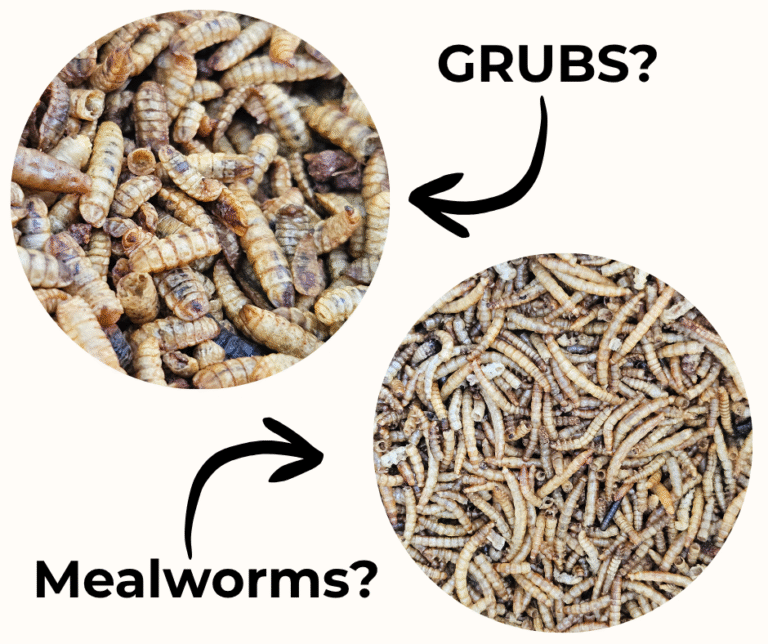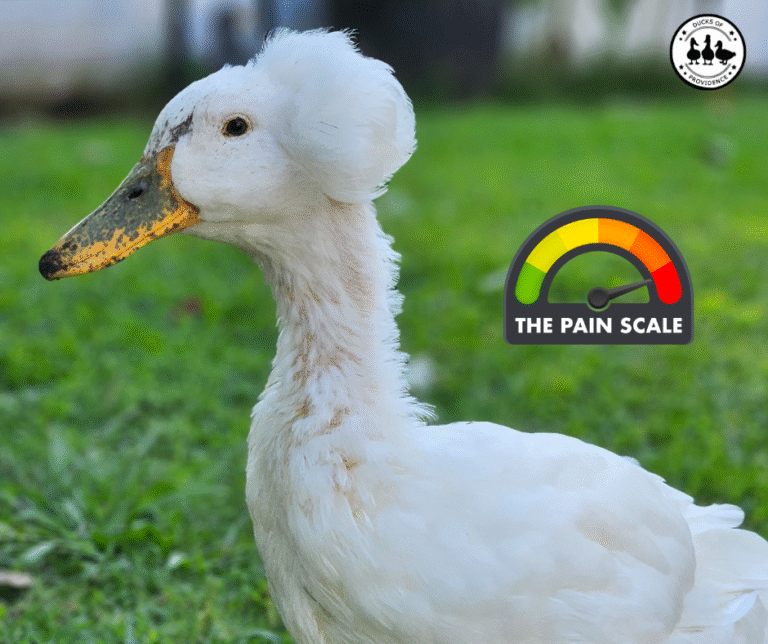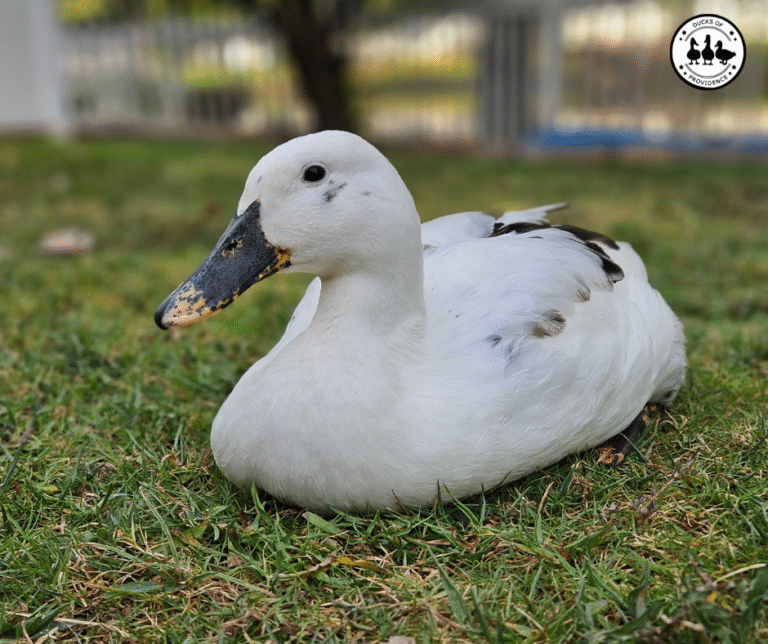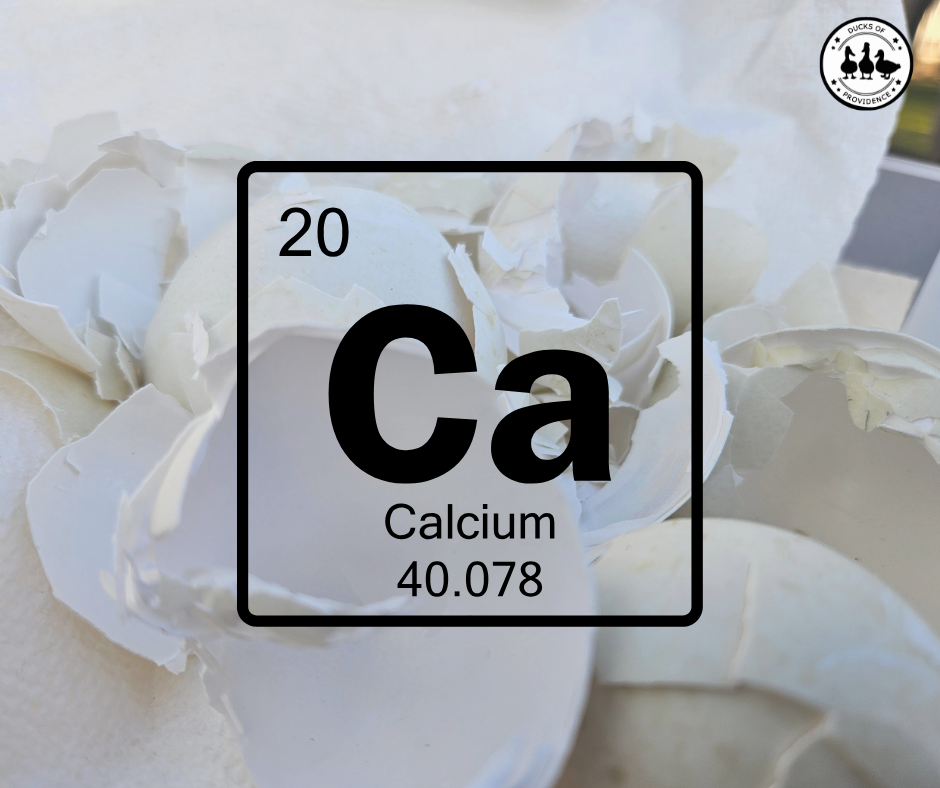
Calcium For Ducks: The Essential Guide to Strong Bones and Healthy Eggs
Calcium may not be the most glamorous nutrient, but it’s one of the most important for ducks. Whether you’re raising ducklings, caring for pet drakes, or supporting laying hens, getting calcium right can make the difference between thriving ducks and serious health issues.
As both a duck keeper and a scientist, I love exploring not only the “how” but also the “why” behind proper duck nutrition. In this post, we’ll dive into the biology and chemistry of calcium, what happens when things go wrong, and how you can make sure your flock gets exactly what they need.
Ducks of Providence is free, thanks to reader support! Ads and affiliate links help us cover costs—if you shop through our links, we may earn a small commission at no extra cost to you. Thanks for helping keep our content free and our ducks happy! 🦆 Learn more
The Science Behind Calcium in Ducks
Calcium plays far more roles in a duck’s body than most people realize. While it’s best known for strong bones and eggshells, it also drives critical chemical and biological processes every second of the day.
- Skeletal strength: Most calcium is stored in bones as calcium phosphate crystals, providing structure and stability.
- Muscle and nerve function: Ducks rely on free calcium ions in their blood to transmit nerve signals and trigger muscle contractions—including the heart.
- Egg production: For laying ducks, calcium is vital. An eggshell is made almost entirely of calcium carbonate, and producing one egg can use up about 10% of a duck’s total calcium reserves.
Calcium in Bones
About 99% of a duck’s calcium is stored in the skeleton, mainly in the form of calcium phosphate (Ca₁₀(PO₄)₆(OH)₂), also known as hydroxyapatite. These crystals give bones their hardness and durability, while the small fraction of collagen keeps them slightly flexible. Without this mineralized structure, bones would bend or break easily.
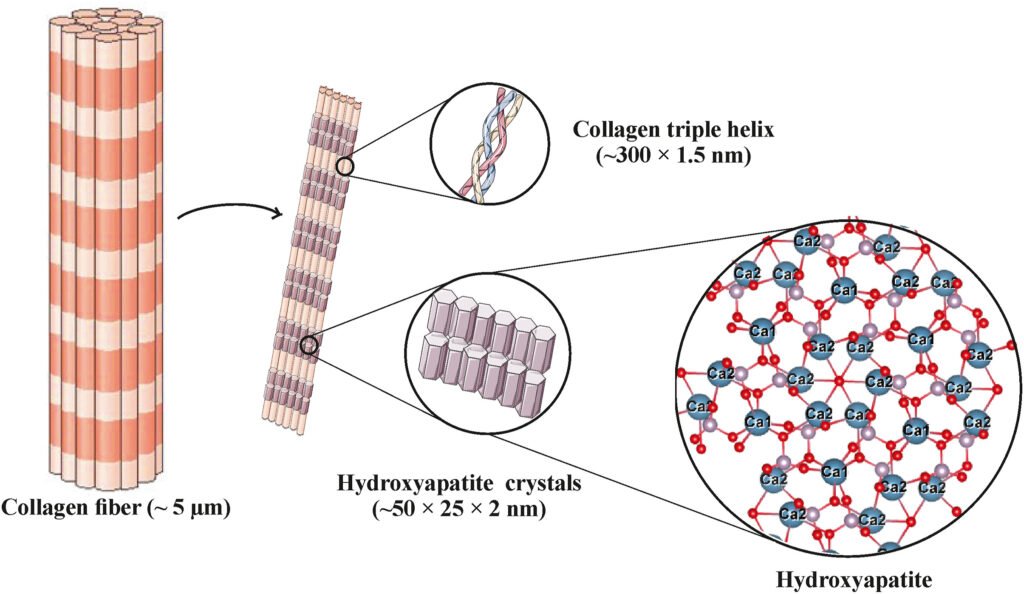
Calcium in Blood and Cells
The remaining 1% of calcium is found in blood and soft tissues, but this fraction is the real workhorse of metabolism. Free calcium ions (Ca²⁺) in the bloodstream regulate:
- Nerve signaling: Calcium triggers the release of neurotransmitters that let nerves “talk” to muscles.
- Muscle contractions: Every heartbeat and every wing flap depends on calcium moving in and out of muscle fibers.
- Blood clotting: Calcium acts as a cofactor in clotting, meaning an injured duck can’t stop bleeding properly without it.
Even tiny shifts in blood calcium levels can have dramatic effects. Ducks, like all birds, keep their blood calcium tightly controlled through hormones such as parathyroid hormone and calcitonin.
Calcium and Eggshell Formation
For laying ducks, calcium’s most visible role is in eggshells. The shell is made almost entirely of calcium carbonate (CaCO₃) crystals, which are deposited layer by layer in the shell gland (uterus) over about 20 hours.
- A single egg can contain 2 grams of calcium.
- This is drawn partly from diet and partly from specialized “medullary bone” inside the duck’s skeleton, which acts as a short-term calcium reservoir during the laying season.
- If dietary calcium isn’t sufficient, the duck’s body will leach calcium from structural bone, leading to brittle bones and long-term health issues.
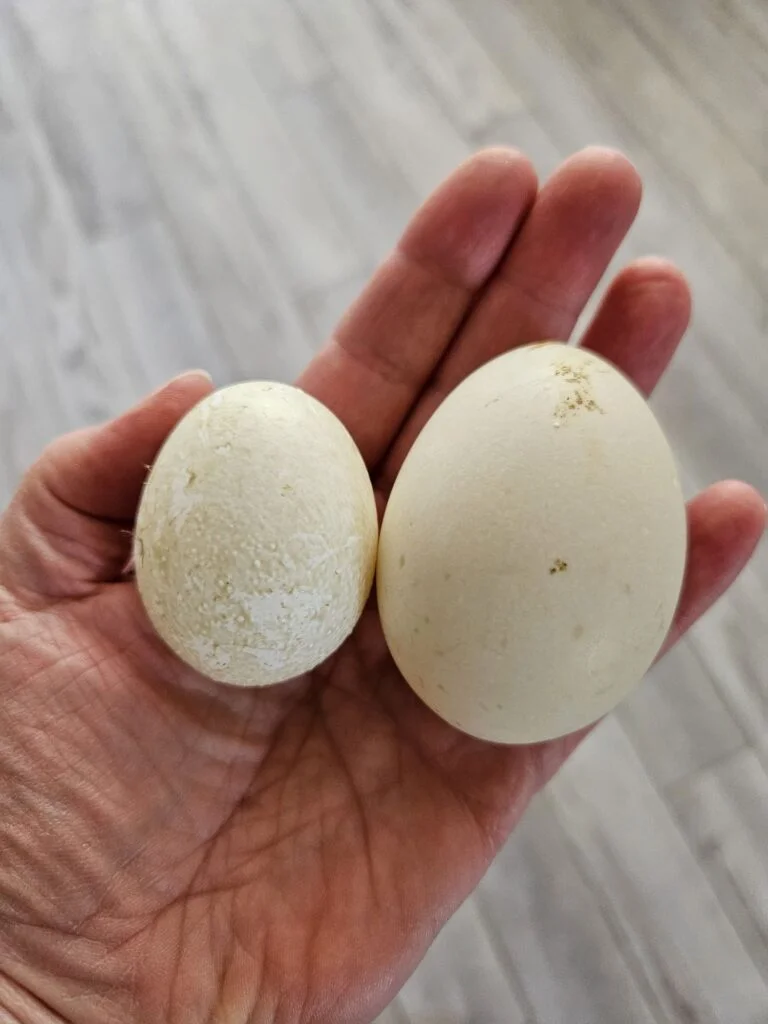
The Chemistry of Balance
The story doesn’t stop with calcium. Ducks rely on a careful interplay of nutrients and hormones to keep everything balanced:
- Vitamin D3 increases calcium absorption in the intestine.
- Phosphorus works with calcium in bone structure; if phosphorus is too high relative to calcium, bones and eggshells become weak.
- Estrogen in laying hens stimulates the production of medullary bone, ensuring calcium is available for eggs.
In short, calcium isn’t just a “supplement”, it’s a mineral woven into nearly every system of a duck’s body, from the smallest cell to the strongest bone.
This is why laying hens often look like they’ve gone through a sudden growth spurt of needs, because in a way, they have.
Calcium Needs for Ducks Across Life Stages
Ducks don’t all need the same amount of calcium. Their requirements shift dramatically depending on age, sex, and whether they are laying eggs. Understanding these stages helps us avoid both deficiencies and excess.
| Life Stage | Calcium Needs | Deficiency Risks | Excess Risks |
|---|---|---|---|
| Ducklings (0–8 weeks) | 0.75–1% (starter/grower feed) | Bowed legs, weak bones, stunted growth | Kidney damage, gout, slowed growth |
| Adolescents / Non-layers | 0.8–1% (all-flock or maintenance) | Brittle bones, weakness | Kidney strain, imbalance with phosphorus |
| Laying Hens | 3.5–4% (layer feed) + oyster shell | Soft/weak eggshells, egg binding, bone loss | Rare (high demand covers intake), but possible imbalance if extreme |
| Drakes | 0.8–1% (all-flock or maintenance) | Weakness, poor feather quality, seizures (severe) | Kidney strain, reduced lifespan |
| Older Ducks (5+ years) | 0.8–1% (all-flock); monitor closely | Fragile bones, reduced mobility | Kidney stones, gout, calcification in tissues |
Ducklings (0–8 weeks)
At this age, calcium is all about bone growth and skeletal development. Calcium and phosphorus work together to mineralize bones, while Vitamin D3 ensures absorption from the intestines.
- Feed requirements: Starter or grower feed formulated for ducklings contains around 0.75–1% calcium.
- Risks of too much: Ducklings cannot process high calcium levels. Excess can damage the kidneys and stunt growth.
- Tip: Never feed layer pellets to ducklings—the 3–4% calcium is far too high for them.

Adolescents and Non-Layers (8 weeks – adulthood, outside of laying season)
Once ducks are feathered out and past their rapid growth spurt, their calcium needs level off. The goal here is maintenance, not storage.
- Feed requirements: All-flock or maintenance feeds usually contain 0.8–1% calcium.
- Risks of imbalance: Over-supplementation can harm kidneys and disrupt phosphorus balance, while deficiencies can cause weak bones.
- Tip: Provide insoluble grit (granite) for digestion. Oyster shell is not needed unless there are active layers.
Laying Ducks
For layers, calcium requirements increase dramatically. Every egg requires about 2 grams of calcium, most of which forms the eggshell.
- Feed requirements: Layer feed contains 3.5–4% calcium.
- Supplementation: Even with layer feed, most hens benefit from free-choice oyster shell.
- Risks of deficiency: Thin-shelled or shell-less eggs, egg binding, bone depletion, fractures, prolapse.
- Tip: Always offer oyster shells in a separate dish. Ducks are excellent at self-regulating intake.
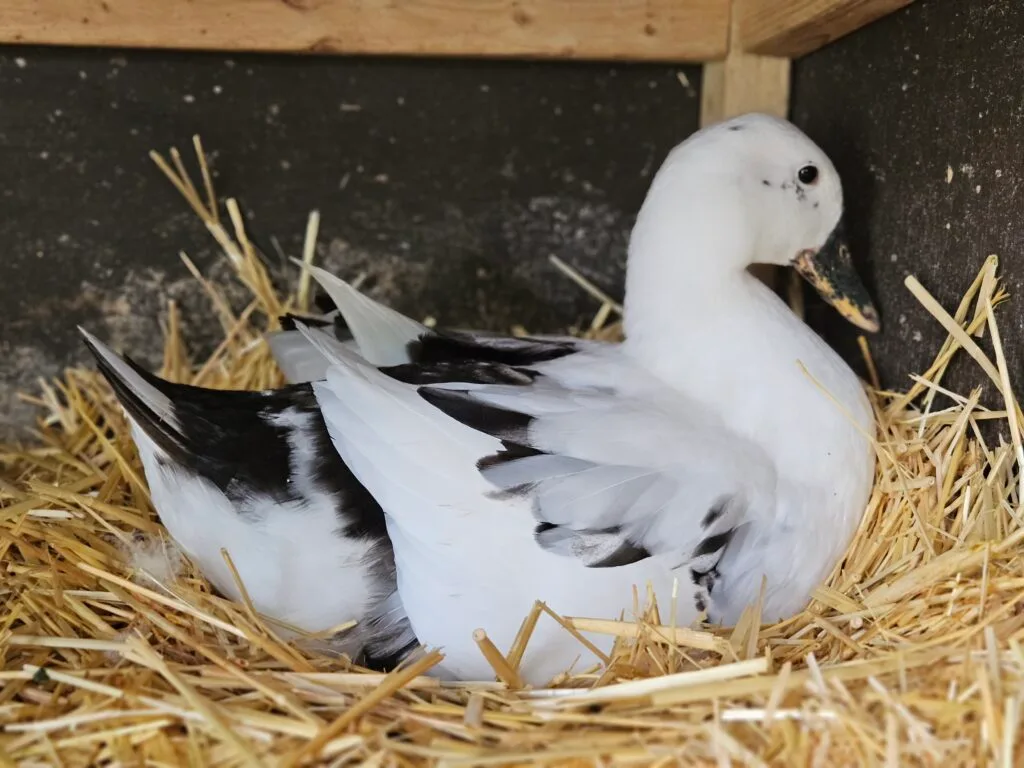
Drakes (adult males)
Drakes do not lay eggs, so their calcium needs are much lower. Feeding them high-calcium diets (like layer feed) over long periods can strain their kidneys.
- Feed requirements: All-flock or maintenance feed with 0.8–1% calcium is ideal.
- Tip: If you have both hens and drakes, avoid feeding layer pellets as the only ration. Use all-flock feed and offer oyster shell separately for the hens.
Older Ducks (5+ years)
As ducks age, their ability to absorb calcium decreases. Even non-layers may suffer from bone weakness.
- Feed requirements: Continue with all-flock feed for drakes and retired hens, but monitor closely.
- Extra support: Short-term supplementation (with Vitamin D3) can help fragile ducks, but should be guided by a vet if ongoing.
- Tip: Provide non-slip flooring like grass, mats, or artificial turf to prevent injuries.
Managing Mixed Flocks
Many backyard duck keepers have a mix of ages and genders in one group. Feeding can feel tricky, but there’s a simple solution.
- All-flock or waterfowl maintenance feed should be the base diet for everyone. This keeps drakes, adolescents, and non-layers safe from excessive calcium.
- Free-choice oyster shell offered in a separate dish allows laying hens to meet their extra needs without overloading the rest of the flock.
- Ducklings in mixed flocks: If you’re raising babies with adults, it’s safest to feed everyone an all-flock feed and provide niacin supplementation for ducklings. Oyster shells should still be available on the side. The ducklings won’t eat it if they don’t need it.
This approach keeps everyone healthy without juggling multiple feeds.
How Wild Ducks Get Their Calcium
Unlike our pet and backyard ducks, wild ducks don’t have oyster shell dishes waiting for them. Instead, they regulate their calcium intake through natural foraging:
- Diet diversity: Wild ducks consume aquatic plants, insects, snails, and small crustaceans—all of which contain trace minerals, including calcium.
- Seasonal strategies: Before and during laying season, female ducks naturally seek out foods richer in calcium, such as mollusks and invertebrates with shells.
- Migration advantage: Many wild species time their reproduction to coincide with peak food availability, ensuring enough calcium and other nutrients for egg production.
- Self-regulation: Just like domestic ducks offered oyster shell, wild ducks instinctively balance their intake based on need—choosing more calcium-rich items when their bodies demand it.
This natural instinct is still present in domestic ducks. That’s why when you provide oyster shell free-choice, hens will only consume it when their bodies are actively preparing or forming eggs.
What Happens in Calcium Deficiency
When ducks don’t get enough calcium, the effects ripple through their entire body. Because calcium is so deeply tied to bone health, egg production, nerve function, and muscle activity, a deficiency can show up in many different ways.
Ducklings
For growing ducklings, calcium deficiency interrupts normal bone mineralization.
- Symptoms: Weak or bowed legs, wobbly walking, enlarged joints, stunted growth.
- Biology behind it: Without calcium phosphate to strengthen the collagen framework of bones, their skeletons stay soft and pliable.
- Outcome if untreated: Permanent leg deformities, difficulty walking, or increased susceptibility to fractures.
Laying Hens
For layers, deficiency is most obvious in the eggs.
- Symptoms: Thin-shelled, misshapen, or shell-less eggs, decreased laying frequency, straining or egg binding.
- Biology behind it: Each egg requires up to 2 grams of calcium, mostly as calcium carbonate for the shell. If dietary intake is too low, hens pull calcium from their medullary bone reserves. Over time, this drains their skeletons.
- Outcome if untreated: Osteoporosis, brittle bones, cloacal prolapse, and life-threatening egg binding.
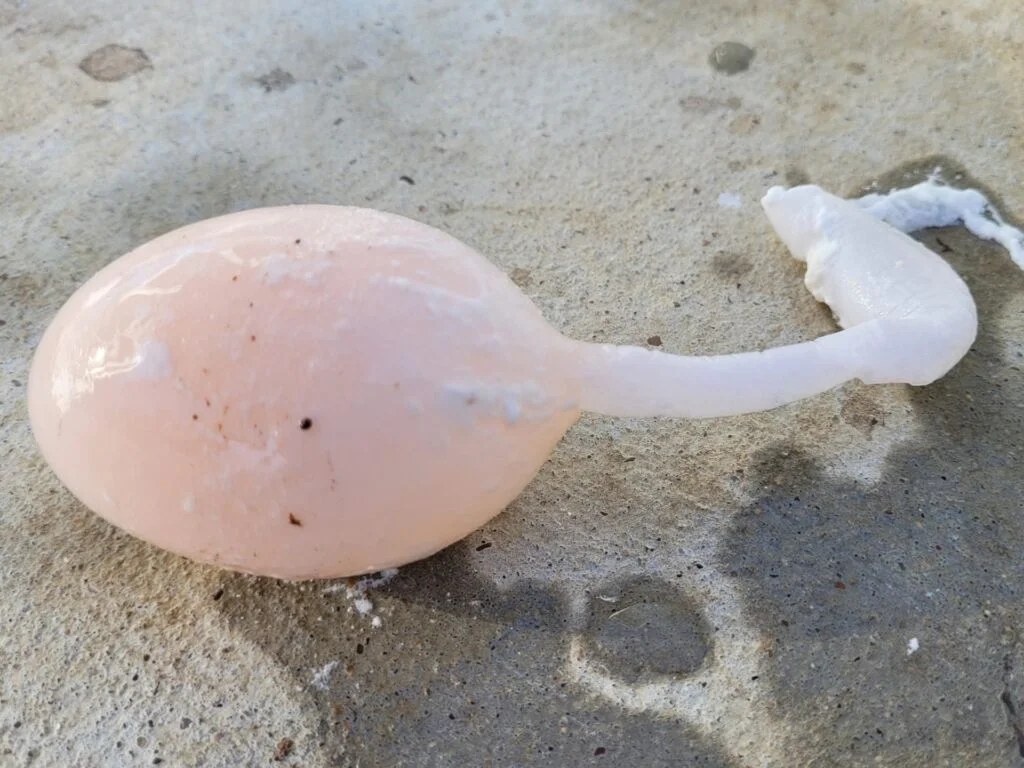
Drakes and Non-Layers
Though they don’t lay eggs, calcium deficiency still matters.
- Symptoms: General weakness, lethargy, poor feather quality, and in severe cases, seizures.
- Biology behind it: Ducks need free calcium ions in their blood to transmit nerve impulses and contract muscles. Without it, normal body function is disrupted.
- Outcome if untreated: Weakness, difficulty moving, and long-term skeletal fragility.
Severe or Chronic Deficiency
If calcium deficiency becomes prolonged or extreme, ducks may experience:
- Fractures from weakened bones.
- Seizures or tremors due to unstable blood calcium.
- Reduced fertility and poor hatchability of eggs.
- Immune suppression, since calcium is also involved in cellular signaling.
What Happens With Too Much Calcium
While calcium deficiency is often the bigger concern for laying hens, excess calcium can cause just as many problems in the wrong ducks. The key issue is that their bodies can only absorb and use so much—anything extra has to be processed and excreted, putting stress on the kidneys.
Ducklings
Young ducklings are the most vulnerable to excess calcium. Their kidneys are still developing and cannot handle the load if they’re fed high-calcium diets.
- Risks: Kidney damage, gout (white urate deposits around joints), slowed growth.
- Common mistake: Feeding layer feed to ducklings. This is one of the fastest ways to cause long-term harm.
Drakes and Non-Layers
Drakes, pet ducks, and retired hens have steady but low calcium needs. They don’t have the huge demands of egg production, so extra calcium just builds up as waste.
- Risks: Kidney strain, reduced lifespan, imbalanced phosphorus metabolism.
- Practical tip: Stick with all-flock or maintenance feed (0.8–1% calcium) and only provide oyster shell separately for layers.
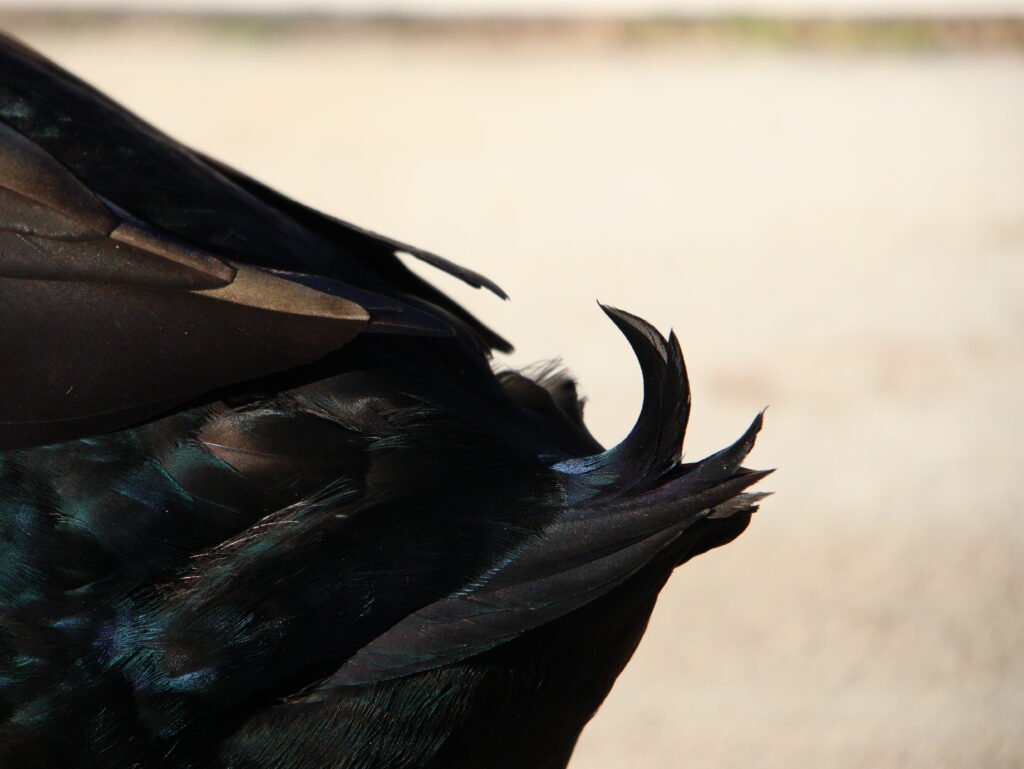
Older Ducks
Even if they aren’t laying, older ducks sometimes receive high-calcium diets out of habit. But with age, kidneys become less efficient at filtering minerals.
- Risks: Increased susceptibility to kidney stones, gout, or urinary issues.
- Practical tip: Monitor diet closely—if they’re no longer producing eggs, they don’t need layer feed.
Why Excess Matters in Chemistry Terms
- Extra calcium in the diet can bind with phosphorus, making it unavailable. This creates a nutritional imbalance that weakens bones instead of strengthening them.
- Calcium crystals can deposit in soft tissues, especially the kidneys, causing calcification damage over time.
Rule of Thumb:
- Feed all-flock feed for mixed flocks with drakes and non-layers.
- Offer oyster shell free-choice for hens in lay.
- Avoid giving layer feed to ducklings, drakes, or non-laying adults—it’s simply too much calcium for them.
When and How to Supplement Calcium For Ducks
Not every duck needs extra calcium, but when they do, the right supplement at the right time can make all the difference. The key is to match supplementation to life stage and condition.
Oyster Shell
The gold standard. Oyster shells are inexpensive, effective, and easy to offer free-choice in a small dish. Ducks are smart enough to take what they need and leave the rest.
However, not all oyster shells are the same, and the form you choose can make a real difference in how well your ducks use them. Based on both scientific understanding and keeper experience, here’s what works best:
1. Flaked Oyster Shell – Best Overall Choice
Flaked oyster shell tends to be the most duck-friendly option. The thin, chip-like pieces are easy for ducks to pick up and dissolve steadily in the digestive system. Because they aren’t too dusty or chunky, ducks regulate their intake naturally without wasting feed.
- Why I recommend it: Gentle on bills, highly digestible, and a consistent calcium source during laying season.
- Product example: Scratch and Peck Oyster Shells— a customer-favorite with fine, uniform flakes.
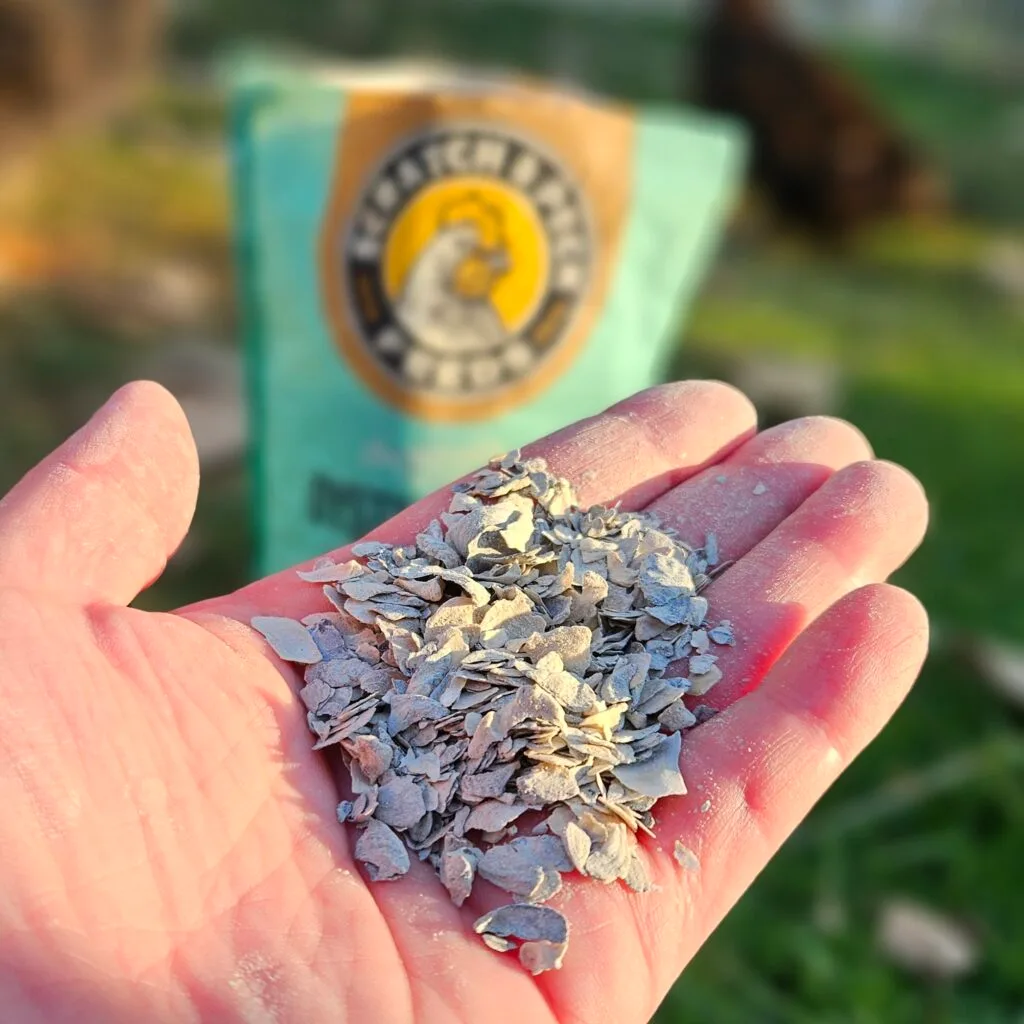
2. Crushed Oyster Shell – Budget-Friendly & Widely Available
Crushed oyster shell, the type you’ll often find at farm stores, works well for most ducks. It comes in small, irregular granules, about the size of coarse sand or tiny pebbles.
- Why I recommend it: Affordable, easy to find at Tractor Supply, feed mills, or online. Ducks consume it reliably, though some batches can be a bit dusty.
- Product example: Manna Pro Crushed Oyster Shell — a popular and well-reviewed option.
3. Fine or Powdered Oyster Shell – For Special Situations Only
Fine, flour-like oyster shell isn’t ideal for free-choice feeding, since ducks can’t regulate intake well and may accidentally consume too much. However, it can be useful in special situations, such as when a vet advises short-term supplementation for a hen with repeated soft eggs or egg binding.
- Why I don’t recommend it daily: Too easy to overdose, and ducks can’t pick at it like they do flakes or crushed shell.
- When it’s useful: Under veterinary guidance, mixed into feed or water for a short period of time.
4. Large Oyster Shell Chunks – Not for Ducks
These are sometimes sold for chickens or other poultry but are not practical for ducks. Large, sharp fragments can be difficult to eat and may even risk bill injury.
Why to avoid: Ducks will likely ignore them, meaning your hens won’t get the calcium they need.
Crushed Eggshells
Crushed eggshells are a simple, sustainable way to recycle nutrients back into your flock. After all, eggshells are made of the same calcium carbonate (CaCO₃) that your hens need to form their next eggs.
- How to prepare: Wash the shells thoroughly, dry them (air-drying works, but you can also bake them at low heat to kill bacteria), and crush them into small flakes. The easiest way to do that is by using a mortar and pestle. The finer the pieces, the easier they are for ducks to eat and digest.
- How to serve: Offer them in a small dish, just like oyster shell, rather than mixing directly into feed. This way, your ducks can regulate their intake.
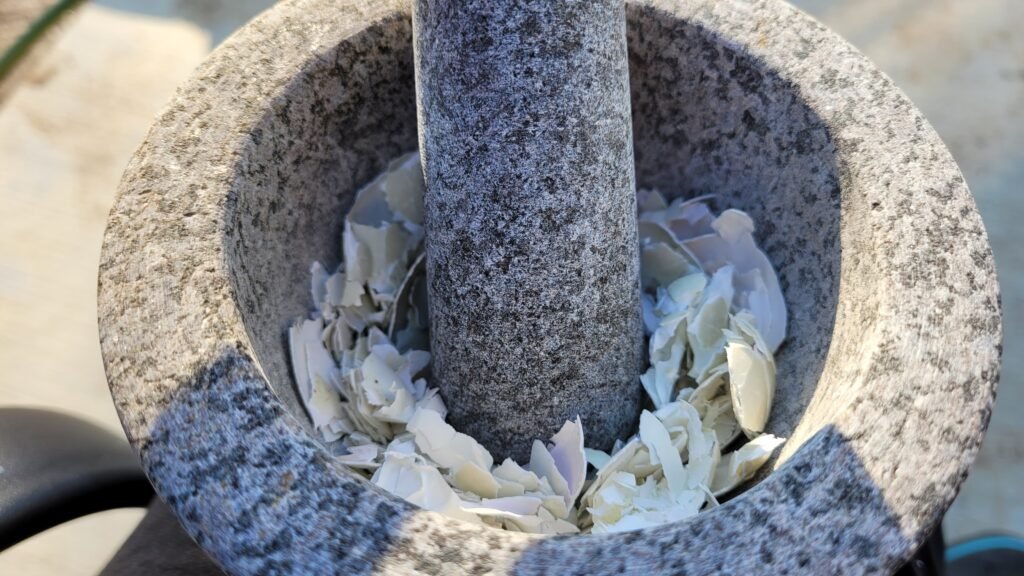
Here’s an important perspective: a duck needs roughly the calcium equivalent of two eggshells to produce a single new egg. That means feeding back eggshells alone usually isn’t enough to cover ongoing production—especially for hens that lay several times a week.
- Pros: Free, eco-friendly, familiar to ducks, reduces waste.
- Cons: Calcium content can vary depending on the egg, and relying solely on eggshells is not enough to meet a laying duck’s needs.
My recommendation: Offer crushed eggshells as a supplement, but always provide a steady source of oyster shell alongside. Think of eggshells as a bonus calcium boost rather than the main supply.
Water-Soluble Calcium and Other Fast-Acting Options
Sometimes a duck needs calcium faster than oyster shell or crushed eggshells can provide. This is especially true for hens laying repeated soft-shelled eggs, ducks struggling with egg binding, or birds recovering from reproductive problems. In these cases, water-soluble or direct calcium supplementation is the most effective route.
Liquid Calcium
Liquid calcium supplements (often calcium gluconate or calcium lactate) can be added directly to drinking water. They dissolve completely and are quickly absorbed through the intestinal lining.
- Use: Short-term, during emergencies or under veterinary guidance.
- Benefit: Rapid absorption into the bloodstream.
- Product example: “Calcivet” drops marketed for birds and reptiles.
Calcium Powder
Avian-specific calcium powders are another option. These are usually sprinkled over food or mixed into water. They often include Vitamin D3, which is essential for absorption.
- Popular form: Calcium carbonate (the same form as oyster shell), but finely ground for faster use, or Calcium Lactate. Examples are UnRuffledRX Bird Calcium, Morning Bird Calcium Plus Powder for Birds, or Zoo Med Avian Calcium.
- When to use: For birds that won’t drink supplemented water, or for a flock-wide short-term boost.
Direct Oral Dosing
For critical cases, liquid calcium can be administered directly by mouth with a syringe (without a needle). This ensures the bird receives the full dose, even if she isn’t eating or drinking well.
- Best practice: Always follow veterinary dosing instructions to avoid overdose.
Calcium Injections
Veterinarians sometimes give calcium injections (often calcium gluconate or calcium glubionate) for ducks in severe distress, such as life-threatening egg binding.
- Why it works: Direct injection into the bloodstream bypasses digestion and provides an immediate calcium boost.
- Important: This is not something to attempt at home—only a vet should perform injections, as incorrect dosing or administration can cause serious complications.
Which Forms Are Most Bioavailable?
Not all calcium sources are absorbed equally. For ducks (and birds in general):
- Most bioavailable: Calcium gluconate (liquid, injectable) and calcium lactate.
- Moderately bioavailable: Calcium carbonate (eggshell, oyster shell, most powders). Effective but requires proper stomach acidity and Vitamin D3 for best absorption.
- Less recommended: Calcium citrate or human antacid tablets—while somewhat bioavailable in people, they aren’t formulated for ducks and may contain additives or incorrect doses.
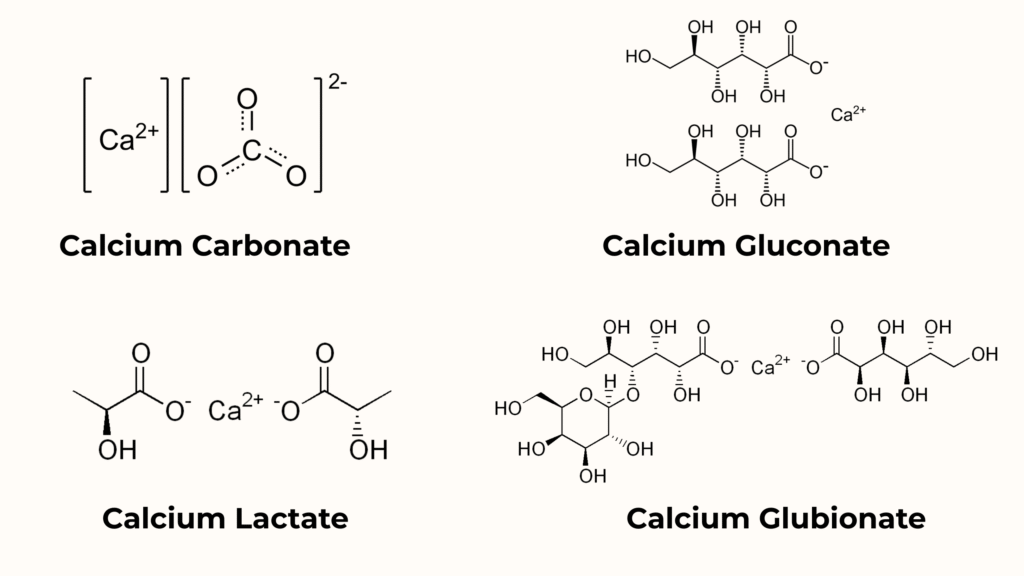
Can You Use Human Calcium Supplements?
It’s tempting to reach for what you have on hand, but caution is needed.
- Human tablets: Often too high in dose, and may include binders, sweeteners, or added ingredients unsafe for ducks.
- Calcium citrate or carbonate tablets: Not harmful in principle, but hard to dose correctly for a duck and not nearly as efficient as avian formulations.
- Best practice: Stick with avian or reptile calcium products, which are formulated for small animals and come with safe dosing instructions.
Grit vs. Calcium
It’s easy to confuse grit with calcium, but the two serve very different purposes in a duck’s body. Ducks often need both—but they are not interchangeable.
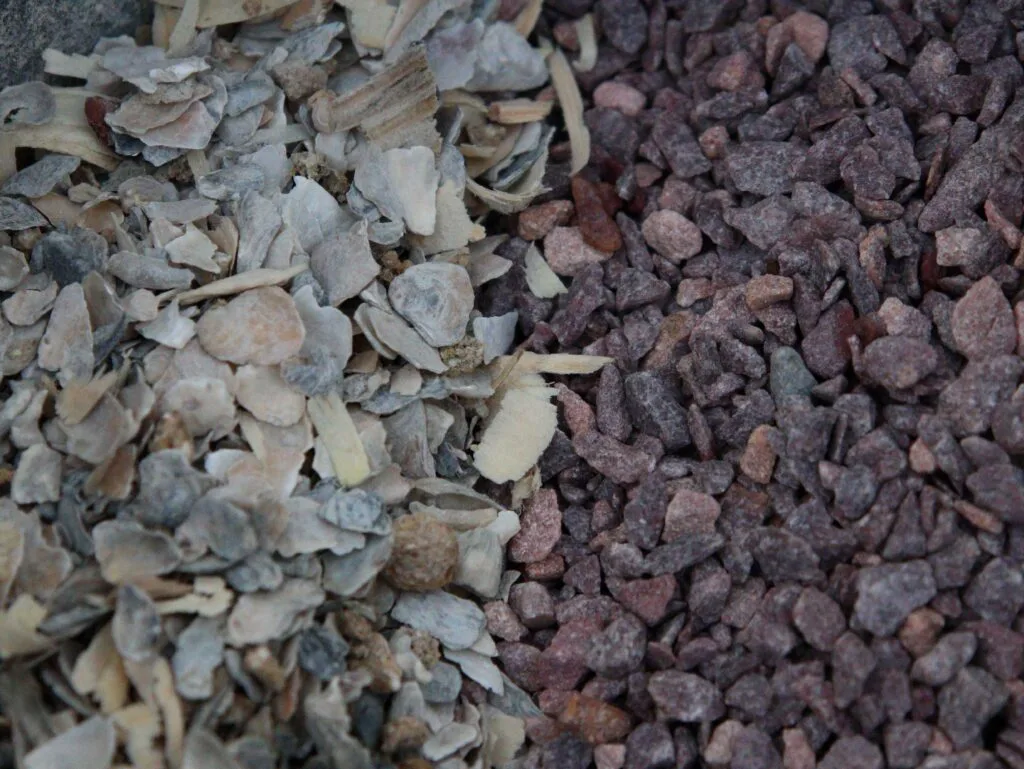
Insoluble Grit
- What it is: Small, hard particles like granite or flint that do not dissolve in the digestive system.
- Purpose: Ducks don’t have teeth. Instead, grit sits in the gizzard and helps grind up fibrous foods like grasses, vegetables, and whole grains. Without grit, ducks can struggle to digest tougher foods properly.
- When it’s needed: Ducks that forage, free-range, or are fed whole grains, veggies, or treats should always have access to insoluble grit. Ducks eating only commercial pelleted feed may not need it as much, since pellets are already soft and crumble easily.
👉 We cover this in more depth in our post: Soluble vs. Insoluble Grit for Ducks
Soluble Grit (Calcium Sources)
- What it is: Substances like oyster shell, crushed eggshells, or limestone that dissolve in the digestive system, releasing calcium ions (Ca²⁺).
- Purpose: Supplies calcium for bone health and eggshell formation. Soluble grit is absorbed into the bloodstream and contributes directly to the body’s calcium pool.
- When it’s needed: Laying hens require free-choice soluble grit to meet the enormous calcium demands of egg production.
Why They’re Not the Same
- Insoluble grit = mechanical digestion aid (stays in gizzard, doesn’t dissolve).
- Soluble grit = mineral supplement (dissolves, absorbed into blood).
- Mixing them together is not recommended. Ducks need the option to regulate both separately, depending on diet and life stage.
Quick Tip: In our flock, I always keep two small dishes side by side: one with oyster shell (calcium) and one with granite grit (insoluble). My hens choose what they need, and my drakes only ever touch the grit. This simple setup ensures no one is missing out.
The Balancing Act: Calcium, Phosphorus, and Vitamin D
Calcium is essential—but it cannot do its job in isolation. Ducks need the right balance of calcium, phosphorus, and Vitamin D3 for their bodies to absorb, transport, and deposit calcium where it belongs. Too much or too little of any one nutrient can throw the whole system off.
Vitamin D3 – The Gatekeeper
- Role: Vitamin D3 (cholecalciferol) is a fat-soluble vitamin that acts like a key to unlock calcium absorption in the intestines. Without it, much of the dietary calcium simply passes through unused.
- How it works: D3 stimulates the production of calcium-binding proteins in the gut lining. These proteins actively transport calcium ions (Ca²⁺) from food into the bloodstream.
- Where it comes from: Ducks produce Vitamin D3 naturally when exposed to direct sunlight, but indoor flocks or those kept under constant cloud cover rely on feed fortified with D3.
- Deficiency signs: Even if calcium is plentiful, lack of D3 can cause rickets in ducklings (soft, weak bones) or persistent soft-shelled eggs in layers.
Phosphorus – The Partner Mineral
- Role: Phosphorus combines with calcium to form hydroxyapatite crystals, the mineral matrix that gives bones their hardness. It’s just as important as calcium in skeletal health.
- The ratio: Ducks thrive when their diet maintains about a 2:1 calcium-to-phosphorus ratio. If calcium is too high and phosphorus too low, the body can’t build strong bone, leading paradoxically to weak bones even in the presence of plenty of calcium.
- Metabolic link: Phosphorus is also critical for energy transfer inside cells (think ATP, the body’s “energy currency”), so an imbalance affects more than just bones.
Protein and Energy – The Delivery System
- Protein: Adequate protein ensures that bone and muscle tissue can grow and repair, and it provides the framework where calcium and phosphorus are deposited. Without enough protein, calcium has no structure to bind to.
- Energy (calories): Ducks need sufficient dietary energy to fuel the transport of minerals. Absorption of calcium and phosphorus is an active process, meaning it requires energy. A malnourished duck won’t be able to fully utilize calcium, no matter how much is supplied.
Why Balance Matters
The body works constantly to keep calcium in the blood within a narrow range. If phosphorus or Vitamin D3 is missing, or if dietary energy is too low, calcium homeostasis breaks down:
- Too much phosphorus: Calcium absorption is blocked, leading to weak bones and poor egg shells.
- Too much calcium without phosphorus: Calcium can precipitate in soft tissues or kidneys instead of going to bones and shells.
- Too little Vitamin D3: Calcium never gets absorbed in the first place, no matter how much is available.
Quick science note: In laying ducks, estrogen also plays a role by stimulating the formation of medullary bone, a special calcium-rich reservoir inside the skeleton. This bone acts like a “bank account,” depositing calcium when it’s abundant and withdrawing it rapidly when eggshells are being formed. Without the balance of phosphorus and Vitamin D3, however, this account can’t be filled properly.
Practical Tips From My Flock
In my own flock, I’ve found that the simplest systems work best. I keep a separate ceramic dish of oyster shell out year-round, right next to the feed. My drake, Simon, and the other non-layers rarely touch it—he gives it the occasional curious nibble but quickly loses interest. My hens, however, especially during laying season, visit the dish daily. It’s fascinating to watch how accurately they self-regulate. One day they’ll eat just a few pieces, and the next, they’ll spend minutes picking through to find exactly what they need.
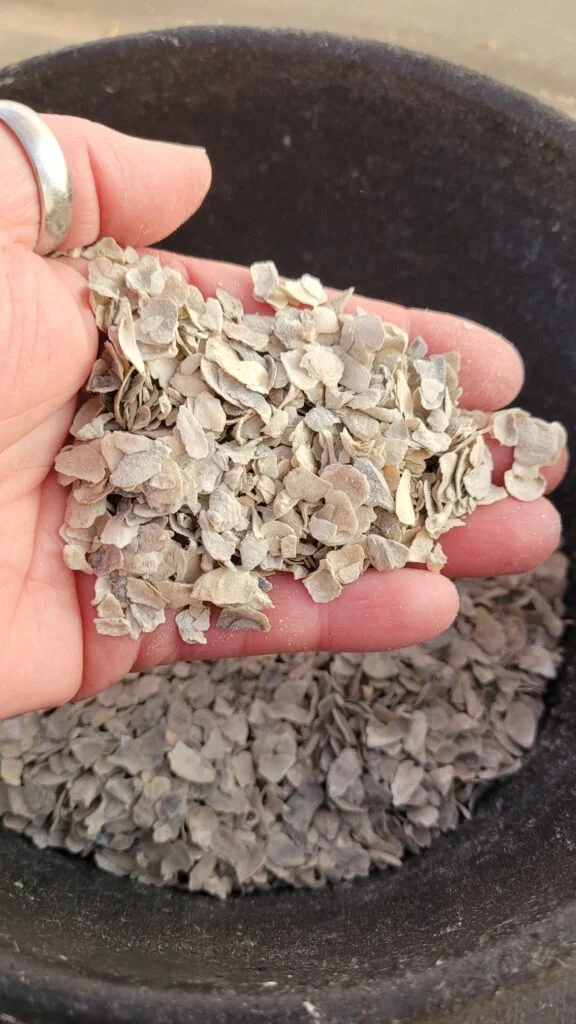
This instinct to balance their mineral intake is something ducks share with their wild relatives. Just as wild ducks seek out snails and mollusks before laying, domestic hens seem to know exactly when their bodies need more calcium.
Still, no matter how careful we are, sometimes a hen needs extra help. When one of my girls began laying a series of soft-shelled eggs, I knew something was off. Even though oyster shell was available, she wasn’t keeping up with demand. On my vet’s advice, I started her on a short course of water-soluble avian calcium with Vitamin D3, added to her drinking water. Within a week, her eggshells were firm again, and she was back to normal.
That experience taught me two lessons:
- Prevention is always best: a balanced diet with oyster shell on the side is enough for most hens most of the time.
- Targeted supplementation can be a lifesaver: having avian calcium products on hand before there’s a crisis saves both stress and time.
Now, I always keep a avian calcium in my first-aid kit, just in case. Thankfully, it doesn’t get used often. But when it’s needed, it makes all the difference.
Recommended Products
Here are a few trusted options that I use or recommend:
- Scratch and Peck Oyster Shells
- UnRuffledRX Bird Calcium
- Morning Bird Calcium Plus Powder for Birds
- Zoo Med Avian Calcium
Affiliate disclosure: If you purchase through these links, I may earn a small commission at no extra cost to you. Every product I recommend is something I’ve researched or used for my own flock.
Final Thoughts
Calcium may seem like a simple mineral, but for ducks it is nothing short of essential. From building strong bones in ducklings to forming sturdy eggshells in laying hens, calcium is woven into every stage of life. When it is in balance, supported by phosphorus, Vitamin D3, and a well-rounded diet, ducks thrive. When it is missing, the results can be heartbreaking, ranging from weak legs and soft-shelled eggs to long-term skeletal damage.
For me, the key lesson has been balance and prevention. I have seen how reliable access to oyster shell keeps my hens strong through laying season, while drakes and non-layers simply leave it alone. I have also seen how quickly things can go wrong when a duck falls behind on her calcium needs, and how important it is to act fast with water-soluble supplements when that happens.
Calcium is not just about eggs. It is about overall health. Proper calcium supports smooth muscle function, heart rhythm, blood clotting, and even the immune system. In other words, getting calcium right is not optional, it is foundational.
For duck keepers, the good news is that meeting these needs is simple:
- Choose the right feed for your flock’s life stage.
- Offer oyster shell or another soluble calcium source free-choice.
- Keep grit available separately for proper digestion.
- Have a backup plan, like liquid calcium with Vitamin D3, for emergencies.
By combining good nutrition with observation and a little preparation, you can prevent most calcium-related issues before they ever take hold. And when you watch your ducks waddle happily, lay healthy eggs, and live long, strong lives, you will know the effort was worth it.
Relevant Articles
- The Science Behind Duck Egg Laying Process: From Ovulation to Oviposition
- Grit for Ducks – Do they really need it? An Essential Guide
- Soft-Shelled Eggs in Ducks – Everything You Need to Know
- Breaking Down Egg Binding in Ducks: What Every Duck Keeper Should Know
- Reproductive Issues in Ducks: What They Are, Why They Happen, and How to Help
- How We Saved Our Egg-Bound Duck (Case Study)
- How We Treated Our Egg-Bound Duck Penny (Case Study)






